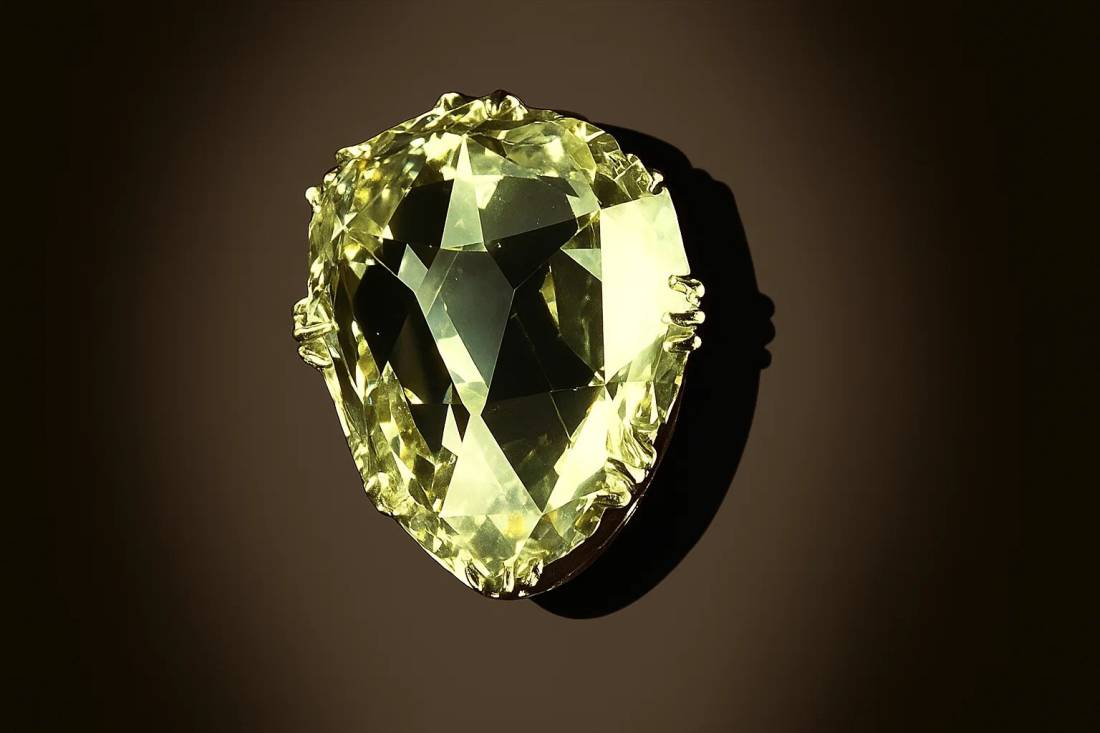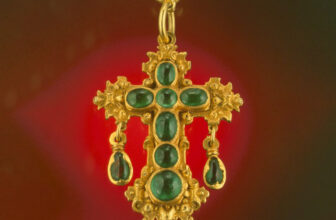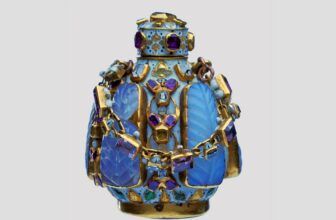
The Legendary Sancy Diamond: A Jewel of Mystery, and History
Diamonds have always captured human imagination, symbols of wealth, beauty, and power that transcend time. Yet among the countless gems that have passed through royal hands, few can rival the aura of mystery and legend that surrounds The Sancy Diamond. Unlike many stones whose stories are relatively straightforward, the Sancy carries within it centuries of intrigue, betrayal, shifting ownership, and the dazzling opulence of Europe’s courts.
This is not simply a story of a gemstone, it is the tale of kingdoms, wars, and men and women who were willing to risk everything to possess a stone unlike any other. Today, the Sancy remains not just a diamond of immense beauty and value, but also a priceless artifact of history.
The Origins of the Sancy Diamond
Unlike many famed diamonds whose mines of origin can be traced, the beginnings of the Sancy Diamond are steeped in mystery. Most historians believe it came from the fabled Golconda mines of India, one of the world’s richest diamond sources during the Middle Ages. The Golconda mines are also the birthplace of other legendary gems such as the Koh-i-Noor and the Hope Diamond.
The stone is a pale yellow, shield-shaped diamond weighing around 55.23 carats. At the time of its discovery, its unusual symmetry and refined cut made it an extraordinary rarity. Many historians suggest that the diamond was cut in India sometime during the 15th century, at a time when diamond cutting was still in its early stages. Its form is unique, not quite brilliant, not quite table-cut, yet so carefully shaped that it exudes a balance and grace admired even today.
But what makes the Sancy Diamond more fascinating than its physical beauty is the journey it took once it left its birthplace.
The Sancy Diamond’s Arrival in Europe
The Sancy Diamond first appeared in Europe in the late 15th century, likely brought by merchants or diplomats involved in the booming trade between East and West. Some accounts suggest it was acquired by Charles the Bold, Duke of Burgundy, a powerful noble who was known for his extravagant displays of wealth.
Charles was an ambitious ruler who often used luxury and pageantry to cement his reputation among Europe’s elite. The diamond may have been part of his treasure, but following his death at the Battle of Nancy in 1477, the stone mysteriously disappeared.
For decades afterward, the gem resurfaced sporadically, changing hands between nobility and monarchs who valued it as a talisman of both beauty and prestige.
Nicolas de Harlay, Seigneur de Sancy
The diamond eventually found its most famous owner, the man whose name it still bears: Nicolas de Harlay, Seigneur de Sancy. Sancy was a French nobleman, diplomat, and soldier who had an eye for valuable objects. In the late 16th century, he acquired the diamond and began using it to secure his influence in royal courts.
One of the most legendary stories tied to the diamond involves Sancy himself. It is said that during a military campaign, he entrusted the diamond to a loyal servant to deliver it for safekeeping. Tragically, the servant was captured and killed by bandits along the way. When his body was later discovered, the diamond was miraculously found inside his stomach, he had swallowed it to prevent it from falling into enemy hands.
This tale, whether myth or truth, cemented the diamond’s reputation as a jewel of loyalty, sacrifice, and immense power.
Disappearance and Reappearance of Sancy Diamond
Like many treasures of Europe, the fate of the Sancy Diamond became entwined with political upheaval. During the French Revolution (1789–1799), the monarchy was dismantled and the crown jewels were looted. In the chaos, the Sancy vanished. For years, it was believed lost forever.
But the diamond reappeared in the 19th century, quietly resurfacing in private collections. Its journey during those lost years remains a mystery, adding another layer of intrigue to its history.
Over the centuries, the Sancy Diamond has passed through the hands of monarchs, aristocrats, and collectors across Europe. Some of its notable owners include:
Charles the Bold, Duke of Burgundy – Possibly the diamond’s earliest European owner.
Nicolas de Harlay, Seigneur de Sancy – The French noble who gave the diamond its name.
Henry IV of France – Wore the diamond as a symbol of power.
Marie de’ Medici – Used it in her coronation regalia.
James I of England – Briefly acquired the stone when it was pledged to him as security for loans.
The French Crown – Kept the stone as part of their crown jewels until it was stolen during the Revolution.
Various private collectors – In the 19th century, the stone traveled through private hands, at times hidden from public view.
Each transition of ownership deepened its mystique, making it not only a jewel but a witness to centuries of European history.
The Sancy Diamond in the French Crown
By the late 1500s, Nicolas de Harlay fell into financial trouble and was forced to part with his prized diamond. He sold it to King Henry IV of France, who valued the stone not only for its beauty but also as a symbol of his power and legitimacy. Henry IV wore the Sancy Diamond proudly, often adorning it in his crown or garments during state occasions.
Following Henry’s assassination in 1610, his widow, Marie de’ Medici, used the diamond prominently in her coronation regalia. Portraits of the queen depict her resplendent with jewels, the Sancy among them, underscoring its role as a marker of royal prestige.
For decades, the diamond remained part of the French Crown Jewels, passing through the hands of monarchs who used it to enhance their authority.
The Curse of the Sancy Diamond
The Sancy Diamond is famed not only for its remarkable beauty but also for the dark legend that surrounds it. Often referred to as cursed, the diamond is believed to have brought misfortune, tragedy, and violent deaths to several of its owners, leaving a trail of intrigue that spans centuries.
The diamond first came into historical prominence in the 15th century when it was in the possession of Charles the Bold, Duke of Burgundy. Charles, a shrewd but ambitious ruler, experienced a series of political setbacks and military defeats. The legend suggests that the Sancy, while dazzling in appearance, carried an ill-fated energy that exacerbated his troubles, ultimately culminating in his death at the Battle of Nancy in 1477. From this point on, the gem became associated with misfortune.
Over the years, the Sancy passed through the hands of European royalty and nobility, often arriving under mysterious circumstances and departing just as tragically. One of the most notable owners was King Louis XVI of France, whose reign ended with the French Revolution. The diamond’s connection to royalty who suffered violent or untimely deaths fueled rumors of a curse that transcended mere coincidence. Other owners reportedly experienced financial ruin, betrayal, or sudden death, reinforcing the diamond’s ominous reputation.
Part of the allure, and fear, of the Sancy lies in its dramatic history as a political and diplomatic tool. Its transfers often reflected the shifting alliances, betrayals, and conflicts of European power struggles. Some historians argue that the diamond’s “curse” is more symbolic than supernatural, representing the perilous lives of those who wielded great power during volatile times. Yet, the repeated pattern of misfortune attached to its owners makes the legend compelling, and it remains one of the most storied diamonds in the world.
The Sancy Diamond in the Modern Era
By the late 20th century, the Sancy Diamond found a permanent home. It was eventually acquired by the Louvre Museum in Paris, where it remains today. The diamond is part of the museum’s famed Galerie d’Apollon, a gallery dedicated to the French Crown Jewels and some of the world’s most remarkable gems.
Visitors from around the globe can admire the Sancy, displayed alongside other historic diamonds. What once was a private possession of kings and queens is now a shared treasure of humanity, protected and preserved for future generations.
What Is the Sancy Diamond Worth?
Placing a monetary value on a diamond as rare and historic as the Sancy is nearly impossible. Unlike commercial diamonds sold on the open market, the Sancy carries centuries of provenance, legendary tales, and cultural significance.
Experts estimate that if it were ever to be sold, a highly unlikely scenario, the Sancy could be worth tens of millions of dollars, perhaps upwards of $50 million or more. But to art historians and jewel enthusiasts, its value goes far beyond price. It is an irreplaceable cultural artifact, the worth of which cannot be measured in currency alone.
The Symbolism and Legacy of the Sancy
The Sancy Diamond is more than just a piece of crystallized carbon. It symbolizes:
Power and Authority – From Henry IV to Marie de’ Medici, rulers used it to project strength.
Loyalty and Sacrifice – The tale of Sancy’s servant who swallowed the stone reflects devotion.
Survival – Despite wars, thefts, and revolutions, the diamond endures.
Mystery – Its unknown early history and lost years continue to fascinate historians.
For centuries, possession of the Sancy was equated with legitimacy and divine right to rule. Even today, its presence in the Louvre connects modern France with its royal past.
Sancy Diamond A Living Legend
Today, the Sancy Diamond resides in the Louvre Museum in Paris, admired for its exceptional pale yellow hue and distinctive shield-like shape. While it no longer carries the same life-threatening risks for viewers, the tales of misfortune and violent deaths continue to captivate historians, gem enthusiasts, and the public alike. The Sancy serves as a reminder that sometimes, history and legend intertwine so tightly that a gemstone can become a symbol of both beauty and doom.
Its pale yellow shimmer is more than just beauty; it is a mirror reflecting the ambitions, struggles, and dreams of the people who once held it.
The Sancy is not merely a diamond, it is history, myth, and treasure woven into one.
From the Golconda mines of India to the gilded halls of European monarchs, from the chaos of revolution to the serene display cases of the Louvre, the Sancy Diamond has lived many lives. Each chapter of its story adds depth to its mystique, making it one of the most captivating gems in history.
What is its true worth? In monetary terms, it could command an astronomical price. But in truth, the Sancy is priceless. It is a relic of the past, a witness to history, and a diamond that has transcended time.
For those who stand before it in Paris today, gazing into its soft yellow glow, the Sancy whispers of kings and queens, loyalty and betrayal, glory and downfall. It reminds us that sometimes, the greatest treasures are not only beautiful, they are immortal. image/ naturaldiamonds




